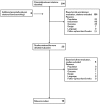The road from intermittently scanned continuous glucose monitoring to hybrid closed-loop systems. Part B: results from randomized controlled trials
- PMID: 31516690
- PMCID: PMC6719474
- DOI: 10.1177/2042018819871903
The road from intermittently scanned continuous glucose monitoring to hybrid closed-loop systems. Part B: results from randomized controlled trials
Abstract
Background: Advances in diabetes technology have been exponential in the last few decades. With evolution in continuous glucose monitoring (CGM) systems and its progressive automation in control of insulin delivery, these advances have changed type 1 diabetes mellitus (T1DM) management. These novel technologies have the potential to improve glycated haemoglobin (HbA1c), reduce hypoglycaemic events, increase time spent in range and improve quality of life (QoL). Our aim was to evaluate the sustained effects in free-living unsupervised conditions of CGM systems (intermittently scanned and real time) and insulin delivery [from multiple daily injections, via sensor-augmented pump therapy and (predictive) low-glucose insulin suspension to hybrid closed-loop systems] on glucose control and QoL in adults and children with T1DM.
Methods: We performed a systematic review of randomized controlled trials (RCTs), using PubMed and the Cochrane library up to 30 May 2019. Inclusion of RCTs was based on type of intervention (comparing glucose-monitoring devices and insulin-delivery devices), population (nonpregnant adults and children with T1DM), follow-up (outpatient setting for at least 8 weeks) and relevant outcomes [HbA1c, time in range (TIR), time in target, time in hypoglycaemia and QoL]. Exclusion of RCTs was based on intervention (exercise, only overnight use). The Preferred Reporting Items for Systematic reviews and Meta-Analyses guidelines were used to score the quality of the papers and for the final selection of the articles.
Results: Our search resulted in 214 articles, of which 19 were eligible. Studies on advanced use in adults and children with T1DM reported increased TIR (all 9 studies); decreased time in hypoglycaemia (13 out of 15 studies); lowered HbA1c levels (5 out of 15 studies); improved QoL (10 of 16 studies) and treatment satisfaction (7 studies).
Conclusions: Recent technologies have dramatically changed the course of T1DM. They are proving useful in controlling glycaemia in patients with T1DM, without increasing the treatment burden.
Keywords: (real-time) continuous glucose monitoring; HbA1c; hybrid closed-loop; hypoglycaemia; intermittently scanned (flash) continuous glucose monitoring; quality of life; sensor-augmented pump; time in range; type 1 diabetes.
Conflict of interest statement
Conflict of interest statement: CDB is a consultant for Abbott, A. Menarini Diagnostics, Lilly, Medtronic, Novo Nordisk, and Roche Diagnostics.
Figures
References
-
- Nathan DM, Genuth S, Lachin J, et al. The effect of intensive treatment of diabetes on the development and progression of long-term complications in insulin-dependent diabetes mellitus. N Engl J Med 1993; 329: 977–986. - PubMed
-
- Bergenstal RM, Tamborlane WV, Ahmann A, et al. Effectiveness of sensor-augmented insulin-pump therapy in type 1 diabetes. N Engl J Med 2010; 363: 311–320. - PubMed
-
- Van Beers CA, DeVries JH, Kleijer SJ, et al. Continuous glucose monitoring for patients with type 1 diabetes and impaired awareness of hypoglycaemia (IN CONTROL): a randomised, open-label, crossover trial. Lancet Diabetes Endocrinol. Epub ahead of print 15 September 2016. DOI: 10.1016/S2213-8587(16)30193-0. - DOI - PubMed
-
- Klonoff DC, Ahn D, Drincic A. Continuous glucose monitoring: a review of the technology and clinical use. Diabetes Res Clin Pract 2017; 133: 178–192. - PubMed
Publication types
LinkOut - more resources
Full Text Sources


